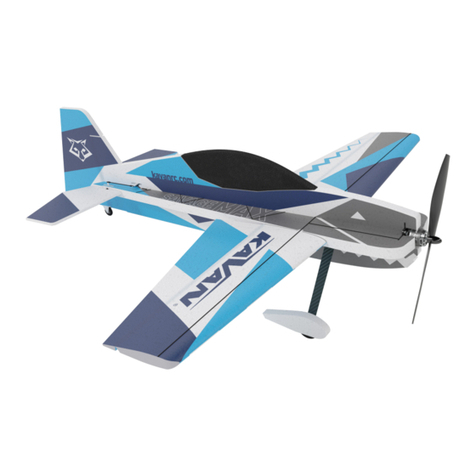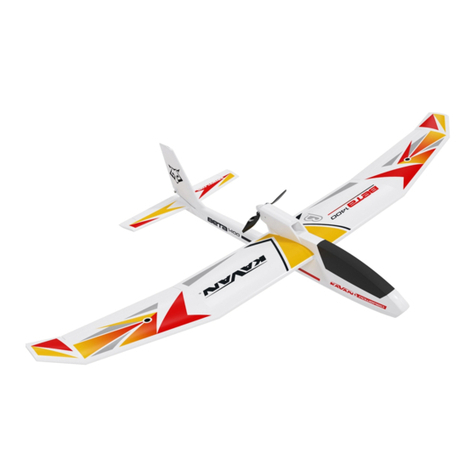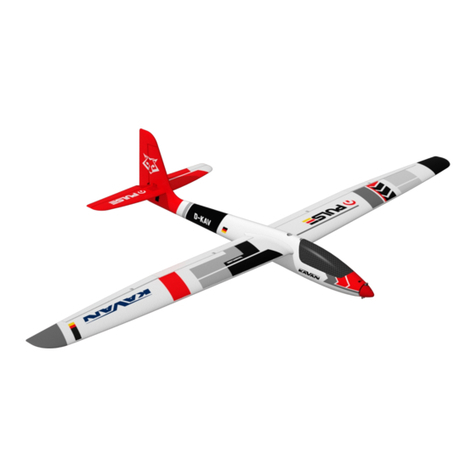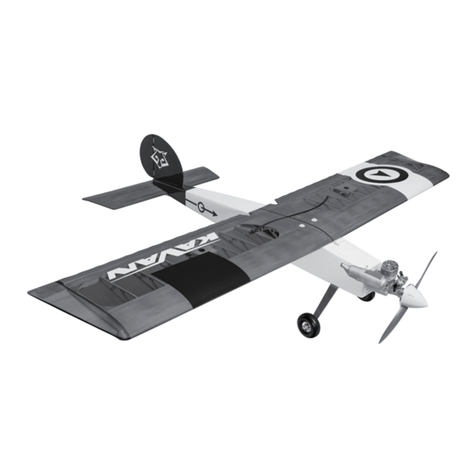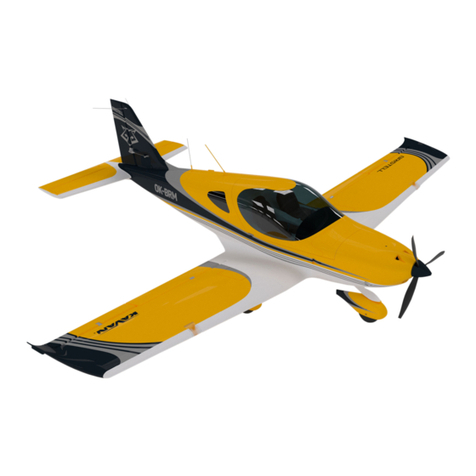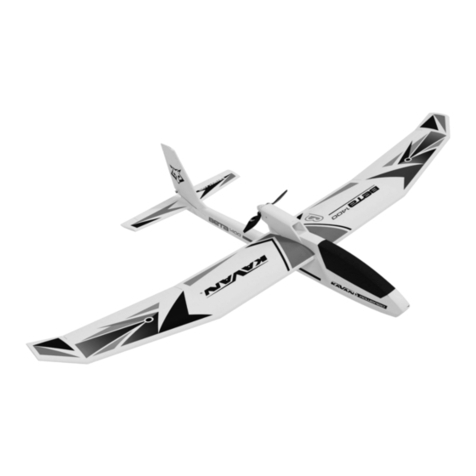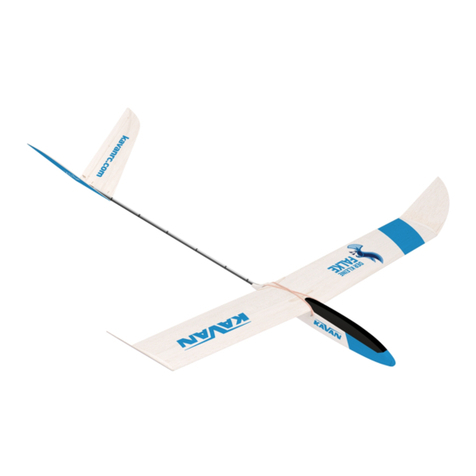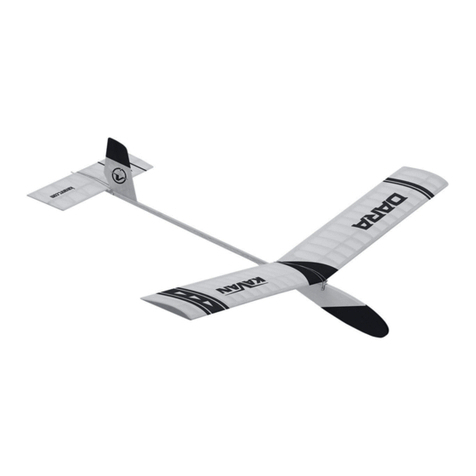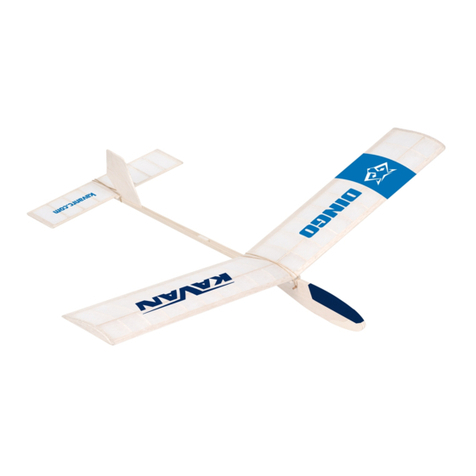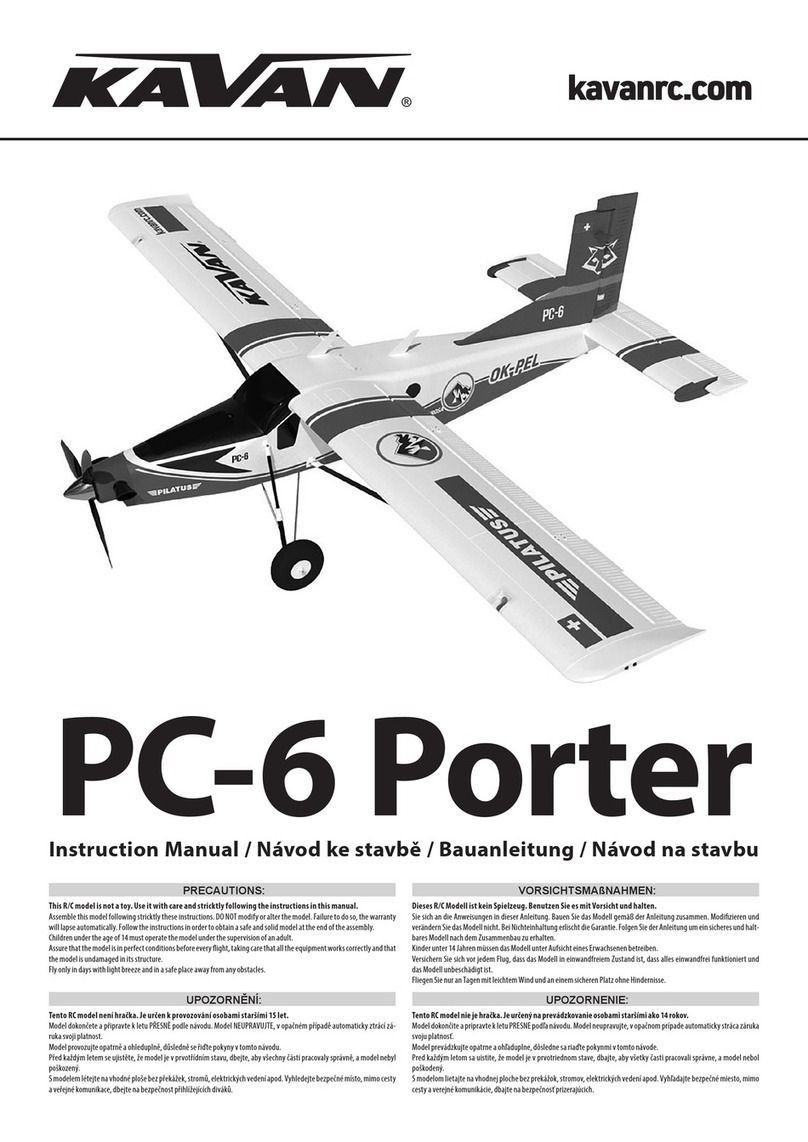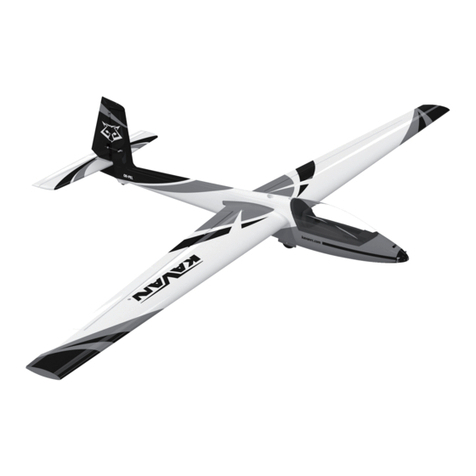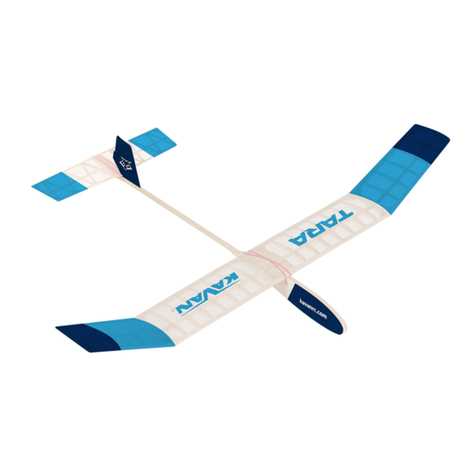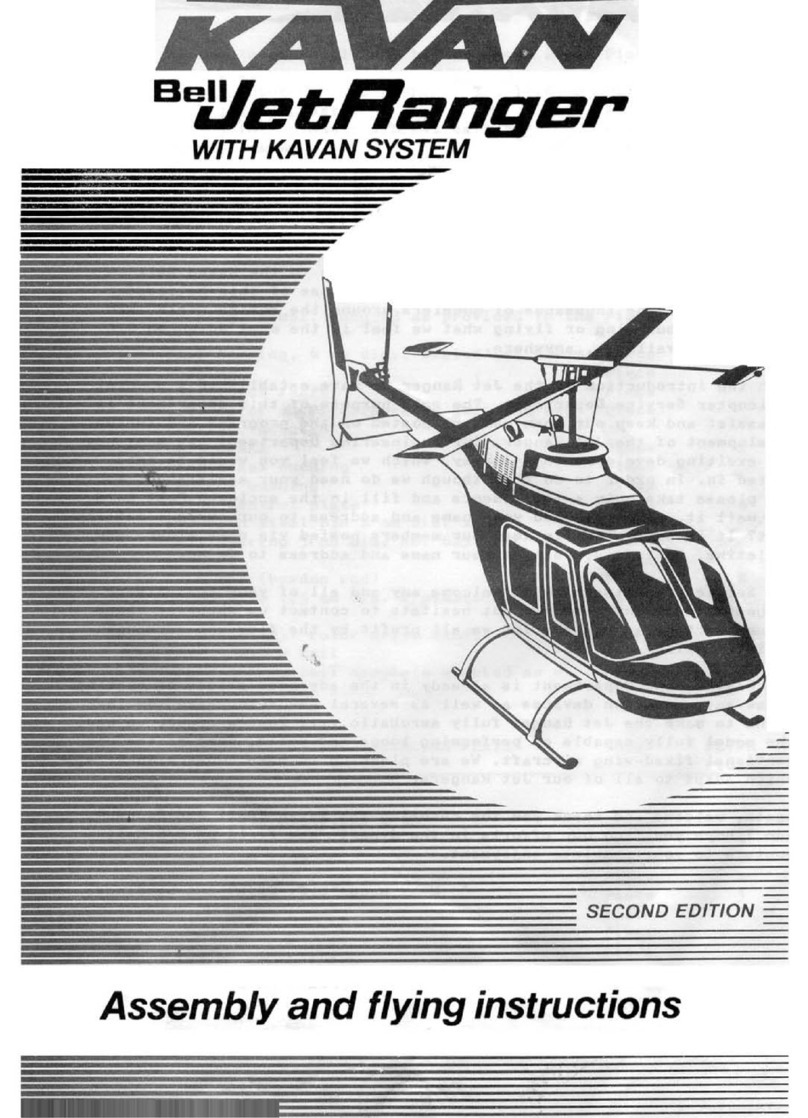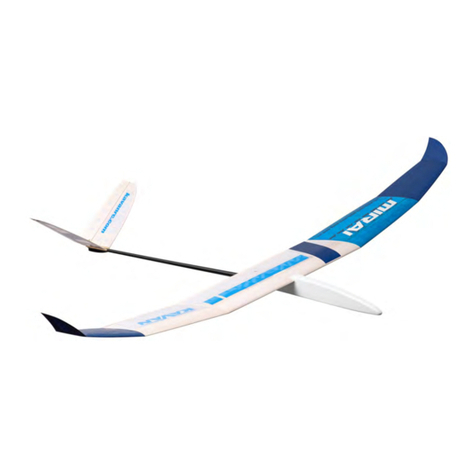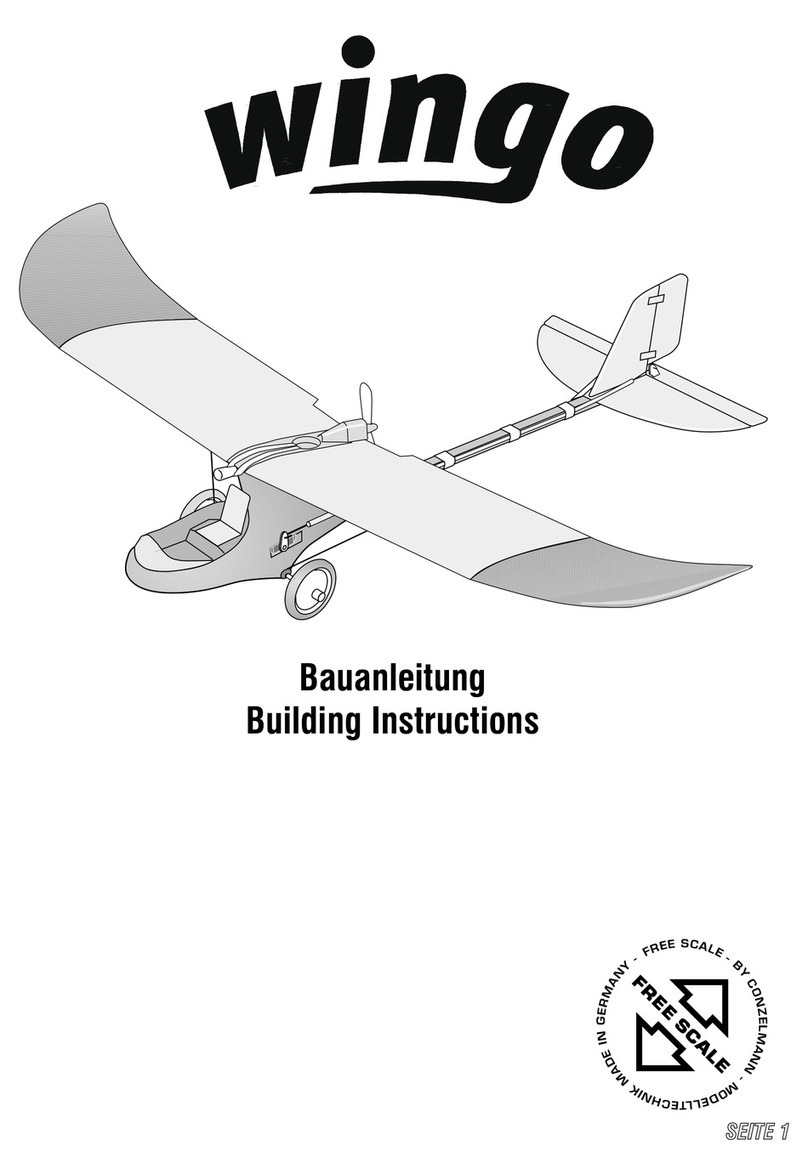
8
vé pásnice 3x05 mm a nalepte ji středním vteřinovým
lepidlem na odtokovou hranu kýlovky. (Obr. 2)
• Všechny díly slepte dohromady středním vteřinovým
nebo disperzním lepidlem. (Obr. 3+4)
Trup (verze větroň
• Připravte si a na sucho bez lepení slícujte díly trupové
gondoly; dle potřeby zabruste. (Obr. 5)
• Na bočnice přilepte překližkové výztuhy a balsové
trojúhelníkové lišty. Slepte a zkompletujte kryt kabiny.
Magnety uzávěru kabiny přilepte ještě před brouše-
ním; nezapomeňte předem vyzkoušet, zda se páry
magnetů přitahují. (Obr. 6+7)
• Slepte přední část trupové gondoly, přepážky nezapo-
meňte zbrousit do úkosu. (Obr. 8)
• Epoxidem vlepte desku se zalepenými maticemi upev-
ňovacích šroubů křídla a přepážky sloužící k upevnění
ocasního nosníku. (Obr. 7+8)
• Vlepte díly nosu trupu a opracujte do správného tvaru
s pomocí dodávané šablony. (Obr. 8+9)
• Nařízněte (do hloubky cca 1 mm) a opatrně nalomte
obě bočnice podél hrany zadní přepážky tak, abyste
vytvořili kónický přechod pro trubkový ocasní nosník
(místo lomu před závěrečným přebroušením prosyťte
řídkým vteřinovým lepidlem). Na přední část ocasního
nosníku (bez zářezů) nasuňte kruhový přechod a kru-
hovou přepážku zakončení trupové gondoly. Trubku
nosníku zasuňte do trupu (zatím nelepte – až po pota-
žení trupu). Všechny díly pečlivě slícujte a zabruste tak,
aby ocasní nosník šel těsně zasunout do trupu a jeho
přechod plynule navazoval na trupovou gondolu. Pře-
pážku zakončující gondolu opatrně přilepte k bočni-
cím (dbejte, abyste ji nepřilepili k ocasnímu nosníku)
a přechod přilepte k ocasnímu nosníku. (Obr. 10+11)
• Nalepte horní a spodní tuhý potah (nezapomeň-
te epoxidem vlepit desku pro vlečný háček). (Obr.
9+10+11)
• Nasaďte kryt kabiny a celou gondolu na jemno za-
bruste tak, aby všechny části včetně přechodu ocasní-
ho nosníku plynule navazovaly. (Obr. 9+10+11)
• Připravte si vlečný háček a vyřízněte otvor pro něj ve
spodku trupu a vyvrtejte otvory pro upevňovací šrou-
by. (Obr. 12)
• Na sucho, bez lepení sestavte pylon vodorovné ocas-
ní plochy (VOP) z překližkového jádra se zasunutými
hliníkovými maticemi pro upevňovací šrouby VOP (M4
vpředu, M3 vzadu) s balsovými bočnicemi a překližko-
vým sedlem. Pylon zkusmo zasuňte do drážky v ocas-
ním nosníku, dle potřeby zabruste a upravte kanál pro
trubici lanovodu výškovky. Jakmile jste spokojeni, jád-
ro a bočnice pylonu slepte dohromady epoxidem a za-
bruste dle obrázku s pomocí dodávané šablony. Nako-
nec epoxidem přilepte sedlo VOP. (Obr. 47A+47B+47C)
Trup (verze elektro)
• Stavba trupu verze elektro je obdobná stavbě trupu
pro větroň s vyjímkou přídě, do níž se vlepí motorová
přepážka. Příď poté zabruste do správného tvaru na-
vazujícího na vrtulový kužel. (Obr. 13-15)
• Před zalepením motorové přepážky se ujistěte, že
otvory v ní odpovídají vašemu motoru – dle potřeby
upravte nebo v krajním případě zhotovte novou, přes-
ně na míru vašemu motoru. (Obr. 13)
Střední část křídla (centroplán)
• Epoxidem k sobě slepte žebra středu křídla; pro přes-
né slícování zasuňte kolíky do připravených 3 mm
otvorů. Pozor: Vytvořte zrcadlově shodný pár žeber.
(Obr. 16+17)
• Mezi připravená středová žebra epoxidem vlepte des-
ku pro upevňovací šrouby křídla. (Obr. 18)
• Epoxidem slepte díly stojiny hlavního nosníku; krát-
kou 0,8 mm překližkovou spojku s otvorem ve středu
na přední stranu hlavního nosníku, dlouhou spojku na
zadní stranu hlavního nosníku. Na koncích stojiny nos-
níku vytvořte kapsy pro uhlíkové spojky z kratší obdél-
níkové 0,8mm překližkové desky vpředu, středového
dílu z 5 mm překližky a delší 0,8 mm překližkové desky
se šikmo seříznutým koncem vzadu. Dbejte, aby do
prostoru kapsy nepronikl nadbytečný epoxid – lepte
se zasunutou uhlíkovou spojkou, kterou vyjmete po
přiložení dřevěných dílů k sobě (nezapomeňte ji ihned
otřít papírovým ubrouskem namočeným v denaturo-
vaném lihu). (Obr. 19+20+21+22)
• Všechna žebra nasuňte na stojinu hlavního nosníku
(zatím nelepte!). Kapsy pro spojky křídla oviňte kevla-
rovou nití a prosyťte středním vteřinovým lepidlem.
(Obr. 23+24)
• Nasuňte pomocný zadní nosník, slícujte náběžnou a
odtokovou lištu. Dle potřeby zabruste. Jakmile všech-
ny díly uspokojivě lícují, můžete střední část křídla
slepit středním vteřinovým lepidlem na plánku polo-
ženém na rovné desce a chráněném tenkou polyetylé-
novou fólií (žebra je vhodnější ke stojině hlavního nos-
níku přilepit disperzním lepidlem). (Obr. 25+26+27)
• Nalepte spodní pásnici hlavního nosníku ze smrkové
lišty 8x2 mm.
• K hornímu tuhému potahu torzní skříně po délce na
tupo přilepte horní pásnici hlavního nosníku ze smr-
kové lišty 8x2 mm a celek nalepte na křídlo disperzním
lepidlem. (Obr. 28+29)
• Koncová žebra střední části křídla zabruste do úkosu
s pomocí dodávané šablony 7°. Poté nalepte koncová
žebra z 3 mm topolové překližky s vlepenými magne-
ty. (Obr. 30)
• Na horní stranu střední části křídla nalepte obvodový
rámeček aerodynamické brzdy a tuhý potah z 1,5 mm
balsy mezi středová žebra s vyříznutými otvory pro
upevňovací šrouby křídla. (Obr. 31)
• Epoxidem vlepte středové položebro s upevňovacím
čepem křídla a 1,5 mm balsou vylepte prostor mezi
středovými žebry zdola. (Obr. 32)
• Na spodní stranu brzdy z 2,5 mm balsy nalepte kolmé
výztuhy. (Obr. 33)
• Celou střední část křídla na jemno přebruste (vč. brzdy).
